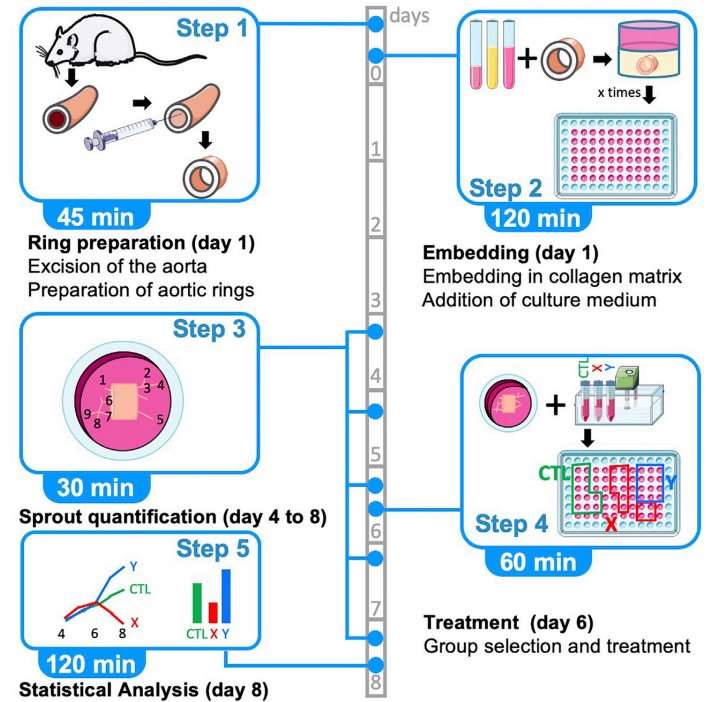Angiogenesis, the sprouting of blood vessels from existing vasculature, is a critical process in both normal and pathological conditions. Various angiogenesis assays, such as the Boyden Chamber assay, wound healing assay, and tube formation assay, typically involve studying individual endothelial cells in culture. However, these assays often use endothelial cell monolayers that have been grown over multiple passages and are highly proliferative, which does not accurately mimic physiological conditions. Furthermore, it's important to note that angiogenesis also involves other cell types (such as pericytes, smooth muscle cells, and fibroblasts) and the extracellular matrix, all of which play important roles in the process.
 Figure 1. The classical aortic ring model is well suited for deciphering pro-angiogenic processes.[1]
Figure 1. The classical aortic ring model is well suited for deciphering pro-angiogenic processes.[1]
The rat aortic ring assay is based on the principle that the aorta is a rich source of endothelial cells and pericytes, which are the key cell types involved in blood vessel formation. By providing the necessary growth factors and conditions, researchers can observe and quantify the formation of new blood vessels from the aortic tissue. This assay is used to study the mechanisms of angiogenesis, identify potential therapeutic targets for angiogenesis-related diseases such as cancer and cardiovascular diseases, and screen for new drugs that can promote or inhibit blood vessel formation.
Creative Bioarray's Rat Aortic Ring Assay offers a cost-effective and efficient solution for researching angiogenesis. Our expertise in angiogenesis research can expedite your research and drug development efforts.
Study Examples:
 Figure 2. Stimulatory effect of recombinant angiogenic factors in the aortic ring assay. Photomicrographs illustrate the angiogenic response in collagen gel cultures of an untreated aortic ring (control) and rings treated with basic fibroblast growth factor (bFGF, 25 ng/ml) or vascular endothelial growth factor (VEGF, 10 ng/ml). [2]
Figure 2. Stimulatory effect of recombinant angiogenic factors in the aortic ring assay. Photomicrographs illustrate the angiogenic response in collagen gel cultures of an untreated aortic ring (control) and rings treated with basic fibroblast growth factor (bFGF, 25 ng/ml) or vascular endothelial growth factor (VEGF, 10 ng/ml). [2]
References:
1. Isabelle et. al. "Rat Aortic Ring Model to Assay Angiogenesis ex vivo." Bio-protocol 5 (20): e1622 (2015). DOI:10.21769/BioProtoc.1622.
2. Nicosia, Roberto F et al. "Paracrine regulation of angiogenesis by different cell types in the aorta ring model." The International journal of developmental biology vol. 55,4-5 (2011): 447-53. doi:10.1387/ijdb.103222rn
Online Inquiry